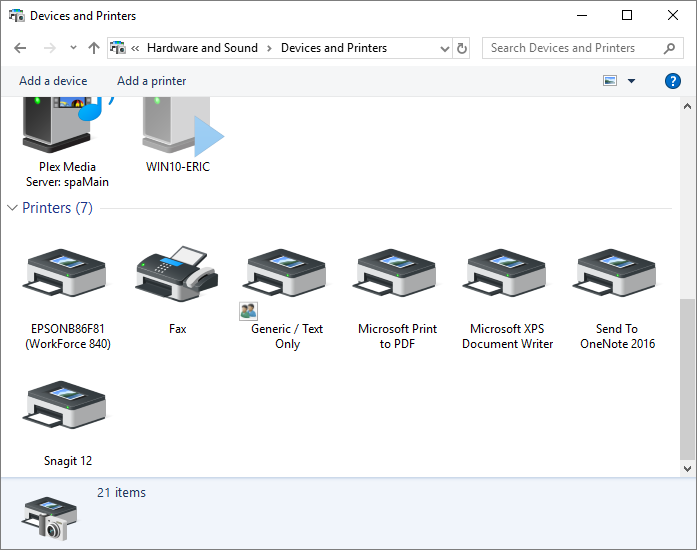Windows can work with a wide assortment of printers, and over time you may change the number and type of printers that have been connected to your system. At some point you may want to delete a printer driver—you may no longer have the printer or it may no longer be accessible from your system. You can delete a printer from Windows 10 by following these steps:
- Display the Control Panel.
- Click on View Devices and Printers under the Hardware and Sound heading. You may have to scroll down a bit to find the Printers section. (See Figure 1.)

Figure 1. The Devices and Printers screen.
- Right-click on the printer you want to remove. Windows displays a Context menu.
- Choose Remove Device from the Context menu. Windows asks you to confirm your request.
- Click Yes. The printer is removed from Devices and Printers screen.
If you are using Windows 8, the beginning steps are a bit different:
- Display the Control Panel.
- Click the Hardware and Sound category link.
- Click the Devices and Printers category link. Windows displays the Devices and Printers screen.
- Right-click on the printer you want to delete. Windows displays a Context menu.
- Choose Remove Device from the Context menu. Windows asks you to confirm your request.
- Click Yes. The printer is removed from the Devices and Printers screen.
- If you are using Windows 7, follow these steps:
- Click Start and then click Devices and Printers. Windows 7 displays the Devices and Printers screen.
- Right-click on the printer you want to remove. Windows 7 displays a Context menu.
- Choose Remove Device from the Context menu. Windows 7 asks you to confirm that you really want to remove the printer.
- Click Yes. The printer is removed from the Devices and Printers screen.
Author Bio
Allen Wyatt
With more than 50 non-fiction books and numerous magazine articles to his credit, Allen Wyatt is an internationally recognized author. He is president of Sharon Parq Associates, a computer and publishing services company. Learn more about Allen...
Changing the Default Drive
Macros can be used to read and write all sorts of files. If those files are on a different drive than the current one, ...
Discover More
Understanding Names
Excel provides the ability to define names that refer to cells or ranges of cells. These can then be used in your ...
Discover More
Printing a Full Style Sheet
Word supports the use of styles (they are very powerful), but it doesn't provide a way to get a full-featured style sheet ...
Discover More
Creating an XPS Document
Creating an XPS document is as easy as printing a document. This tip explains how.
Discover More
Printing to a PDF File in Windows 10
Want to easily create a PDF file from your favorite program? Windows 10 makes it easy with a built-in PDF printer driver. ...
Discover More
PDF on Demand
Many times, it helps to have a PDF of a file that can be distributed electronically when physical printouts are not ...
Discover More

![]()
![]()
![]() This tip (10720) applies to Windows 7, 8, and 10.
This tip (10720) applies to Windows 7, 8, and 10.
Comments